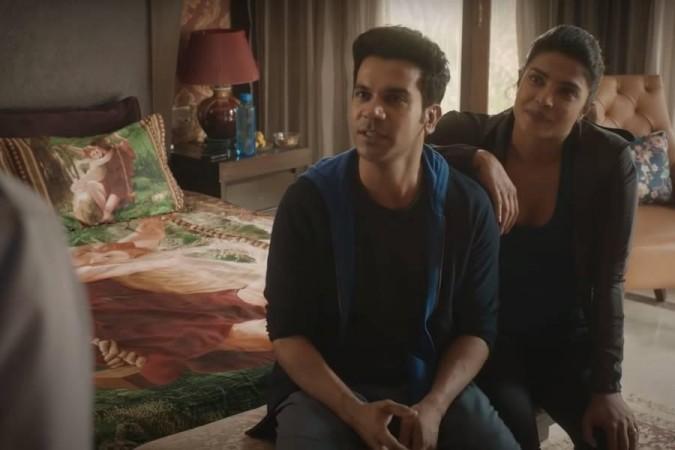The White Tiger is a brilliantly written, furnished and designed piece of work, with an ensemble cast where the two of the bankable A-listers of the Hindi film industry, Priyanka Chopra and Rajkummar Rao have humbly taken a back seat to allow the fledgeling performers to shine.
The visually descriptive narrative pendulums from luxurious smoothness of the 5-star hotels, (that one character is fatefully given the chance to experience) to the dirty, cockroach encroached underground where the same character faces a different reality.

In your second viewing, you can see how the narrative amplitude of detail which gives the film a flavour.
Some media channels quickly see a semblance of the plot with the Oscar award-winning film Parasite but it must be remembered that Arvind Adiga's book was written in 2008. The book had become one of the best sellers in New York much before the South Korean film had gone on floors and received international recognition.
So what's it's genre? Thriller? Social Drama? It's none
It's difficult to put The White Tiger in a category since the film resonates far beyond its generic limits -- a film about status envy, aspirations, westernisation, Sanskritisation, patriarchy, materialism (among the upper class and bottom strata of society) and the idea of having servants at your beck and call.

More than this, it is about the suppressed horror of falling down from luxury and sharing a room with a man who has nothing more than a dusty mattress.
Breaking the stereotypes
The satirical frames extend to a vision of the higher class and lower class sharing the same sofa with resentful intimacies of watching the lower class man scratch his groins, and have spit marks on his shirt.
There's no concept of hero, or villain in The White Tiger but more about changes which take place in a man's life due to circumstances. Various stereotypes about the upper class, middle class and lower class sections of India have been shattered and re-explored with an immense amount of research.

The 70s were a phase when the rich men in Bollywood were usually considered to be the evil ones, while the poor were portrayed as the large-hearted, charitable heroes. The perception had been followed even in the 90s films too, but there is a considerable shift in this decade.
Being poor does not make you innocent
Balram (Gourav Adarsh) hails from the rural region of India, and he never misses an opportunity to abandon his family. He sulks at the thought of visiting his hometown and psychologically manipulates Pinky (Priyanka Chopra) and Ashok (Rajkummar Rao) with various kinds of lies about India's heritage and culture.
Ashok and Pinky, who hail from the affluent section of India with top-notch connections with politicians, are seen as the warmest human beings, but they don't realise that their sense of entitlement is so ingrained in them which only gets exposed when they face the worst of circumstances.
They wish their servant warmly, calls him their son but slaps him right across his face when Balram makes an effort to emotionally connect with them. Balram too is no saint either and plans his own path to succeed in life when the lady luck knocks at his door.
There are two types of Indians
Pinky and Ashok represent two kinds of Indians -- the one who wants to visit India but permanently settle abroad, and Ashok who wants to live in India and witness the transformation of New India where everyone would be digitally connected. Pinky invariably brings forth American cultural traits in her behaviour.
She has a genuine interest in visiting the rural areas but feels no qualms in physically exposing herself in the presence of Balram, (who is their servant). Ashok on the other hand deals with modernity in true sense.

He wants to watch India become a better country, allows Balram a scope for discussion, but due to his father's shady affairs, he becomes a victim of different circumstances. Despite living in Delhi's posh hotel with top-notch security, he remains unaware of the danger lurking around him, watching him like a hawk.
The class divide and the caste divide
While Arvind Adiga had narrated the class divide in simple Indian English, Ramin Bahrani has brought it out in frames. In each of his screenplay, he visually juxtaposed the extreme divide between the affluent people of the country and the ones who help them in their daily lives.

For fans, who have been extremely eager to watch Rajkummar Rao play the 'rich guy', this might be a refreshing break. Rajkummar Rao and Priyanka Chopra may appear impressive, but we know very well that they are capable of being much more than this.
Acting and performances
Despite A-listers Priyanka Chopra, and National award-winning artist Rajkummar Rao, Adarsh Gourav has become the show-stealer in The White Tiger. Although he narrates the entire film, he speaks more with his expressions, body language than with dialogues. Balram is a boy who hails from the rural outskirts of India and he is too determined about not being under the control of his grandmother.

In Adiga's book, there had been an interesting story which made Balram hate his family, but that remained visually missing in the film. The evilness of the granny is hardly explored and she appeared like a regular old granny who speaks in a squeaky voice.
The home invader here gazes at his super-rich employers and watches himself in a shiny mirror where he gets new ideas of escaping from his wretched life.

The White Tiger taps into a rich cinematic tradition of unreliable servants but this time with an intimate knowledge of their employers, and intimacy that easily converts into hostility. Since the film follows a non-linear pattern of narration, we remain aware of possible different circumstances, which keep us hooked to the film.
Is it worth the watch: Yes
Rating: 4 stars


!['Had denied Housefull franchise as they wanted me to wear a bikini': Tia Bajpai on turning down bold scripts [Exclusive] 'Had denied Housefull franchise as they wanted me to wear a bikini': Tia Bajpai on turning down bold scripts [Exclusive]](https://data1.ibtimes.co.in/en/full/806605/had-denied-housefull-franchise-they-wanted-me-wear-bikini-tia-bajpai-turning-down-bold.png?w=220&h=135&l=50&t=40)








!['Had denied Housefull franchise as they wanted me to wear a bikini': Tia Bajpai on turning down bold scripts [Exclusive]](https://data1.ibtimes.co.in/en/full/806605/had-denied-housefull-franchise-they-wanted-me-wear-bikini-tia-bajpai-turning-down-bold.png?w=220&h=135)


![Nayanthara and Dhanush ignore each other as they attend wedding amid feud over Nayanthara's Netflix documentary row [Watch]](https://data1.ibtimes.co.in/en/full/806599/nayanthara-dhanush-ignore-each-other-they-attend-wedding-amid-feud-over-nayantharas-netflix.jpg?w=220&h=135)